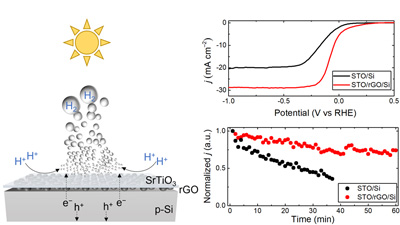Harvesting and conversion of the solar energy into the hydrogen fuel primarily relies on an efficient and stable materials. The researchers from Advanced Materials Department, Thin Films and Surfaces Department and Surfaces Engineering Department of Jožef Stefan Institute recently demonstrated that via a facile approach, the high-performing photoabsorber, silicon substrate, can be well protected by a robust strontium titanate (SrTiO₃) layer from corrosion under photoelectrochemical water splitting operations. In collaboration with National Institute of Chemistry and Institute of Physics of the Czech Academy of Sciences, the results were published in the journal ACS Applied Materials & Interfaces. The study has realized that by using a buffer layer of reduced graphene oxide (rGO) on silicon substrate, the crystallinity and morphology of the deposited SrTiO₃ protection layer could be tailored accordingly, so that the durability of the silicon substrate and its photoelectrochemical performance are greatly improved compared to the properties of the individual components.
